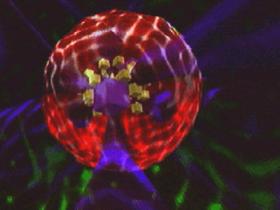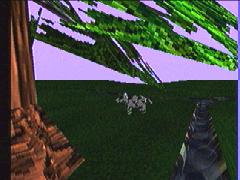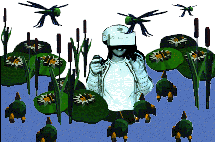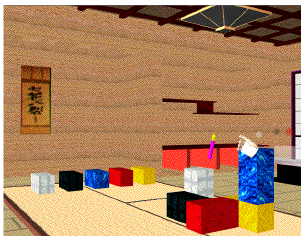
The HIT Lab Learning Center has developed a number of virtual environments (VE’s) for leaning. To test your understanding of using VE’s, see if you can imagine being immersed in the following worlds. What steps would be required to create these worlds? What objects would be needed? How would you want to interact with these worlds? What learning could take place?
Chemistry World
Designed for use in the high school science curriculum, Chemisty World allows participants the opportunity to construct atoms and molecules from objects that represent protons, neutrons and electrons. Participants can also control the energy level and spin of the electrons, thus determining their orbits. Currently, the world allows participants to create atoms ranging from Helium (1 electron) to Carbon (7 electrons). Eventually, functionality will be enhanced so learners can construct more complex atoms or to begin to create simple chemical compounds (H2O, for example).

Tree World
This world is a designed to teach elementary students about how trees grow and interact with the surrounding environment. Although it is not intended to be a comprehensive primer on ecology, this world does offer a basic introduction to plant biology and what trees and the associated ecosystem they support need to be healthy . This world also serves as the base environment for elementary students who are being introduced to world-building. The students’ task is to add creatures who use or who live in trees. After the student s enter the world and make the tree healthy , all of these creatures appear and the ecosystem is once again in balance.

Nitrogen World
One hundred and twenty grade seven students, working on a unit on wetlands ecology as part of their biology curriculum, built four worlds that modeled the processes of the water, energy, nitrogen and carbon dioxide cycles. The students' task was to demonstrate the processes operating in each cycle by manipulating the objects they had built and accounting for the results. For example, a student would "grab" some energy from the sun, use it to evaporate water in a pond, pick up the water vapor and lift it into the sky to form clouds and make it rain. Or a student could "feed" plants to herbivores, herbivores to carnivores and observe animal and vegetable material decaying to return nutrients to the soil.

Zengo Sayu
This is the first functioning virtual environment ever created specifically to teach foreign language. It makes use of both virtual reality and speech recognition technology. Students absorb and practice the target language -- Zengo Sayu was originally designed to teach Japanese prepositions -- as they move through the environment and interact with virtual objects.

These are just some of the VE’s for learning developed by the HIT Lab Learning Center. What other worlds should we be working on? If you had the opportunity, what virtual world would you build? Use the survey to tell us more.